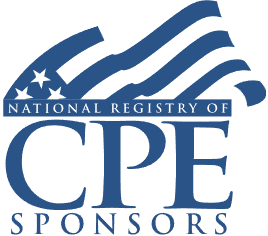Self-Directed IRAs and Unusual Investments: Prohibited Transactions, RMDs, Valuation Issues, and Correcting Errors

Course Details
- smart_display Format
On-Demand
- signal_cellular_alt Difficulty Level
Intermediate
- work Practice Area
Tax Preparer
- event Date
Thursday, July 21, 2022
- schedule Time
1:00 p.m. ET./10:00 a.m. PT
- timer Program Length
110 minutes
-
BARBRI is a NASBA CPE sponsor and this 110-minute webinar is accredited for 2.0 CPE credits.
-
BARBRI is an IRS-approved continuing education provider offering certified courses for Enrolled Agents (EA) and Tax Return Preparers (RTRP).
This webinar will detail self-directed IRA (SDIRA) requirements, including allowable investments, required minimum distributions, valuation issues, and prohibited transactions. Our panel of federal tax experts will review relative court cases and PLRs and offer advice for correcting past IRA errors.
Faculty

Mr. Matta's experience includes advising large plan fiduciaries, financial institutions and investment professionals in connection with the structuring and marketing of investment products and financial services to benefit plans and other tax-exempt investors. Mr. Matta focuses on the intersection of ERISA Title I (and similar laws applicable to governmental plans) with securities, tax, corporate and banking laws as they relate to financial products and financial services.

Mr. Bergman is a the founder and CEO of IRA Financial Technologies, a custodian and leading provider on self-directed retirement plans. He is also the owner of two leading pension administration IRA Financial Group and IRA Financial Trust are the market's fastest growing providers of self-directed retirement plans. Mr. Bergman is the author of 8 books on self-directed retirement plans and a leading voice in the self-directed retirement market. He is a frequent contributor to Forbes.com and is a member of the Forbes Finance Council. Mr. Bergman has been interviewed on CBS News and has been quoted in over one hundred and thirty major news publications—among them Businessweek, CNN Money, Forbes, Bloomberg, USA Today, and American Lawyer—in the area of retirement tax planning.
Description
Most taxpayers purchase stocks, bonds, and mutual funds in their retirement accounts. Taxpayers often use SDIRAs to buy alternative investments, including cryptocurrency, land, hedge funds, or racehorses. SDIRAs are subject to the same rules under Sections 408 and 408A as other IRAs; however, complying with these rules is usually more difficult for SDIRAs. Finding a custodian, valuing the assets at year-end, and making required minimum distributions can all be problematic.
Since SDIRAs are often funded with larger and more complex investments, they are targets for IRS scrutiny. Numerous court cases and PLRs detail prohibited transactions, including self-dealing that can negate the IRA subjecting the taxpayer to taxes and penalties on the entire investment. Individuals and tax practitioners need to understand how to contribute to SDIRAs without running afoul of these guidelines.
Listen as our panel of retirement plan experts explains how to benefit from alternative IRA investments while meeting current compliance requirements.
Outline
- SDIRAs: introduction
- Unusual investments
- Cryptocurrency
- Coins
- Land
- Other
- Valuation issues
- Prohibited transactions
- Required minimum distributions
- Correcting IRA errors
- Court cases and PLRs
- Best practices
Benefits
The panel will review these and other critical issues:
- What types of investments cannot be contributed to an IRA?
- What valuation methods are used to correctly determine the year-end values of unusual investments in IRAs?
- Caveats and considerations of holding real estate in an SDIRA
- Maintaining necessary liquidity in an SDIRA
- What transactions are prohibited for IRAs and SDIRAs?
NASBA Details
Learning Objectives
After completing this course, you will be able to:
- Determine specific actions that constitute self-dealing for an IRA
- Identify assets that are not allowable IRA contributions
- Ascertain methods to value unusual assets at year-end that are in SDIRAs
- Decide how to correct improper and excess contributions made to IRAs
- Field of Study: Taxes
- Level of Knowledge: Intermediate
- Advance Preparation: None
- Teaching Method: Seminar/Lecture
- Delivery Method: Group-Internet (via computer)
- Attendance Monitoring Method: Attendance is monitored electronically via a participant's PIN and through a series of attendance verification prompts displayed throughout the program
- Prerequisite: Three years+ business or public firm experience preparing complex tax forms and schedules, supervising other preparers or accountants. Specific knowledge and understanding of individual income taxation, including itemized deductions, individual income tax credits, net operating loss limitations including carrybacks and carryforwards.

Strafford Publications, Inc. is registered with the National Association of State Boards of Accountancy (NASBA) as a sponsor of continuing professional education on the National Registry of CPE Sponsors. State boards of Accountancy have final authority on the acceptance of individual courses for CPE Credits. Complaints regarding registered sponsons may be submitted to NASBA through its website: www.nasbaregistry.org.

Strafford is an IRS-approved continuing education provider offering certified courses for Enrolled Agents (EA) and Tax Return Preparers (RTRP).
Unlimited access to premium CLE courses:
- Annual access
- Available live and on-demand
- Best for attorneys and legal professionals
Unlimited access to premium CPE courses.:
- Annual access
- Available live and on-demand
- Best for CPAs and tax professionals
Unlimited access to premium CLE, CPE, Professional Skills and Practice-Ready courses.:
- Annual access
- Available live and on-demand
- Best for legal, accounting, and tax professionals
Unlimited access to Professional Skills and Practice-Ready courses:
- Annual access
- Available on-demand
- Best for new attorneys
Related Courses

Admitting New Partners: Tax Consequences
Friday, May 30, 2025
1:00 p.m. ET./10:00 a.m. PT

Key Issues in Succession Planning: Buy-Sell Agreements, Equity Grants, Profits Interests, Tax Considerations
Tuesday, June 17, 2025
1:00 p.m. ET./10:00 a.m. PT
Recommended Resources
How CPE Can Bridge the Gap Between What You Know and What You Need to Know
- Career Advancement